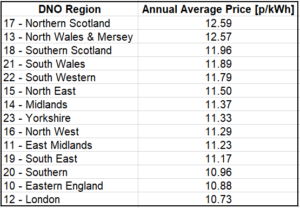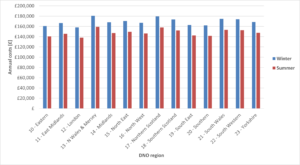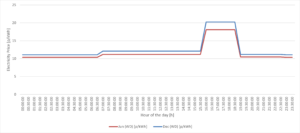Our Research Project
This academic project aims to inform UK non-domestic consumers about the dynamics of their tariffs which are subject to their location in the grid. Our data platform allows accessing bespoke electricity datasets so consumers can drive positive change in their organisations.
On our website sections you can find:
- Explanations about the electricity bills charges
- Information about contract types and electricity price comparisons
- An overview of the main stakeholders involved in the electricity bill
- An API to access HH electricity cost datasets for any GB location
- A News section to keep updated with market changes
Interested to know about the UK regional electricity prices?
UK Regional Electricity Prices
The electricity prices of non-domestic consumers are influenced by the time and location that the customer consumes electricity. This characterisation is a result of the aggregation of different charges that compose the electricity bill, a more detailed explanation of these charges can be accessed here.
Did you know that every region has a different electricity price?
Our analysis indicates that UK regional electricity prices (p/kWh) for the year 2020-21 vary slightly across regions. The areas with the highest Distribution Network Operator (DNO) charges for the low voltage (LV) level are where electricity is most expensive.
It is important to mention that these estimated electricity prices do not consider the TNUoS charges, Dloss, Tloss, and, for the DUoS components, just the unit rate is considered. Check the electricity bill charges explanation to know more about these charges.
The figure below shows the estimated annual average electricity price in p/kWh for LV sites for all DNO regions.

Did you know that electricity prices are slightly higher in the winter months?
UK electricity prices also vary depending on the seasonality as there are variations in commodity and other charges.
Our analysis indicates that the winter months (columns in blue) are slightly higher than the summer months (columns in red), as shown in the figure below.

Did you know that electricity prices can be higher between 4 pm and 7 pm?
If you are under a flexible contract, electricity prices can vary during the day and hence it is important to know when prices are higher to avoid higher costs.
The peak price period is usually the hours of the day when the national electricity system demand is highest. In the UK, this time period is usually between 4 pm to 7 pm.
The figure below shows the estimated daily half-hourly (HH) electricity price (p/kWh) of a commercial building in the DNO region 10 (Eastern England) for a weekday in January and June.

Want to know more about your electricity costs and participate in our project?
We are looking for non-domestic energy consumers to engage with our online resources, provide ideas, feedback and become more energy aware in this complex and dynamic energy context!